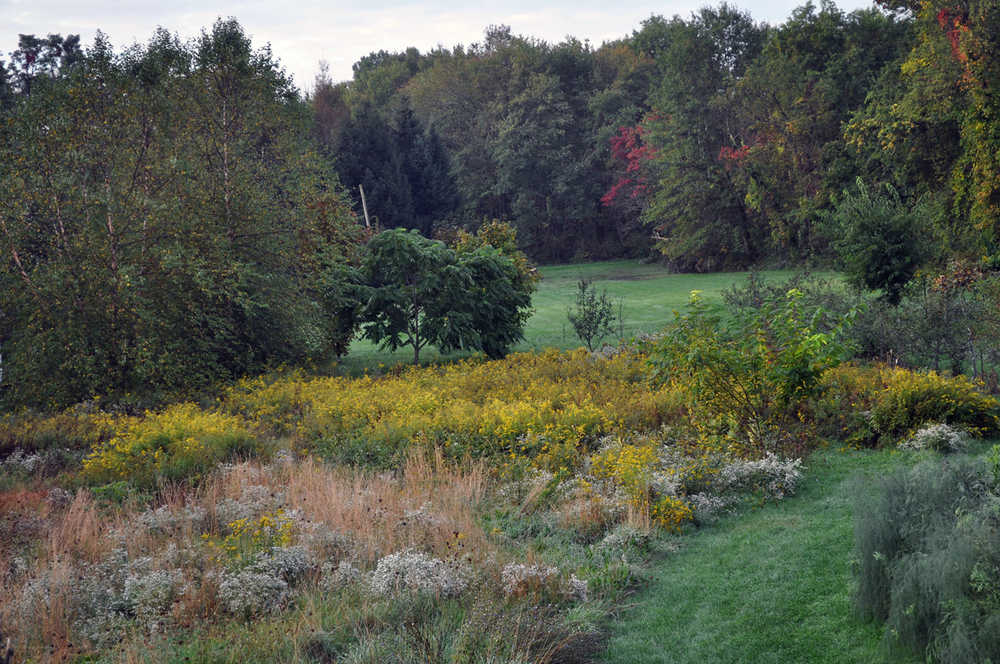Weeks of lawn mowing can make a backyard meadow — a carefree carpet of flowers and grasses — seem like an especially appealing alternative.
Even small yards can accommodate a patch of meadow.
Although a mature meadow requires little maintenance, thorough preparation and planning is needed to establish it. Don’t let “meadow in a can” or some other promise of an instant meadow fool you into believing that just sprinkling seeds or rolling out a seeded, biodegradable carpet will result in a carefree riot of season-long color.
You need to plan because meadow plants are not set out in neat, easily weeded rows. That would ruin a meadow’s random charm. The goal, therefore, is to create conditions as weed-free as possible before setting out plants or sowing seeds.
Scale is your first consideration; a small site raises different practical issues than a large one does.
For a small meadow, mow the existing vegetation; smother it beneath four or more layers of overlapping, wetted paper (such as newspaper); and then blanket the paper with some weed-free organic material to hold it down.
Suitable materials for covering the paper include compost, marsh hay, sawdust and straw. Wood chips are also suitable, and are widely available and often free. You can set wildflower and grass transplants right into wood chips that are not too coarse. (Meadows do need a certain amount of grasses, bunch grasses, for soil stabilization.) If the chips were sitting around wet and are already on their way to decomposition, all the better. For planting seeds rather than transplants, cover the paper with compost.
A large meadow presents more ground than can be feasibly covered with paper and mulch. Successful planting is a combination of art and science, so it may be wise to plant a part of it each year, learning as you go. At any rate, begin by mowing — to literally even out the playing field.
Once mowed, the vegetation needs to be killed, and herbicide or tillage is the most practical way to do this on a large scale. The herbicide Roundup kills any plant it touches, but has known and unknown environmental and health hazards. Less effective but more benign “organic” alternatives exist, such as repeated sprays with household-strength vinegar to which a little dish detergent and oil has been added, or commercial products containing citrus oil, clove oil or special formulations of soaps.
Tillage presents a more bucolic scene for ground preparation than herbicide spraying. A few passes with a rototiller are needed to thoroughly break up and kill plants. Tillage should be shallow to minimize the amount of soil — and weed seeds — brought to the surface, and to minimize the destruction of soil structure and organic matter.
To fight off weeds and to protect the surface from wind and water erosion, sow a “cover crop” such as rye or buckwheat or, even better, successive cover crops. After a season of cover crops, the meadow is ready for planting.
Timing is critical to get meadow plants off to a good start ahead of weeds. Generally, the best time for planting is autumn or spring, when soils are most consistently moist. Timing for natural rainfall is not as critical for smaller areas that can be hand-watered.
Fine-tune your planting further according to the kinds of plants you’re growing. Transplants must take firm hold of the soil before winter settles in, so set them in the ground in either early spring or late summer.
If you’re planting seeds, sow them in late fall, after temperatures have turned too cold for germination, or wait until spring. The optimum time to plant seeds that sprout only in warm weather — these include some grasses and annual flowers such as cape daisy, annual phlox and prairie aster — is late spring. Distribute these seeds evenly, first mixing them with sand and then dividing the mix into two equal batches that you sow separately, the second batch spread in a direction perpendicular to the first.
If everything goes as planned, the soil is laid bare for a minimum amount of time, seeds sprout and transplants take hold quickly, and you’re soon enjoying your meadow with only a minimum of spot weeding.

